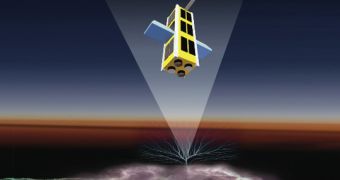Back in 1991, scientists were in for a big surprise after the launch of NASA's Compton Gamma Ray Telescope. Instead of just providing the expected data referring to high energy-emitting supernovae, black holes or the like, it detected gamma ray bursts incoming from the Earth as well. Further tests and missions confirmed the finding, which led to the necessity of a closer investigation. This is what a NASA team, including Doug Rowland from the Goddard Space Flight Center, is trying to achieve with the Firefly tiny probe.
Among the many theories that refer to the potential sources of such gamma ray bursts from the Earth (besides the nuclear explosions triggered by humans, which cannot account for the occurrence rate of the observed phenomenon), the leading one involves that terrestrial gamma ray flashes (TGFs) caused by lightning. But "So far there's just circumstantial evidence" for this, Rowland told Discovery. More specifically, lightning's powerful electrical fields turn neutral gas into electrons and ions and throws them in space.
The generated flashes are as short as a fraction of a second, yet they are surprisingly strong – about 30 times stronger than a cosmic ray, although much less powerful than radiation from a supernova. The small dedicated device called Firefly has been built to test this theory further. Even more, it also aims to investigate a phenomenon indicated by Firefly co-investigator Allan Weatherwax, from the Siena College in New York.
He believes that the electrons emitted during the flashes affect satellites and other spacecraft. "With all the satellites flying up there, there is a real desire to understand how this radiation works," shared Weatherwax. All the scientific instruments will be comprised by a football-sized craft dubbed CubeSat which will be launched in two or three years as a secondary payload. Firefly's mission will last for three years and will cost about $1 million.
Its lead engineer, Joe Kujawski, claims latest breakthroughs in solar cell technology and electronics fields made this happen, "These two advances allow us to put functional science instruments in a package 4 inches by 4 inches by 12 inches".

 14 DAY TRIAL //
14 DAY TRIAL //